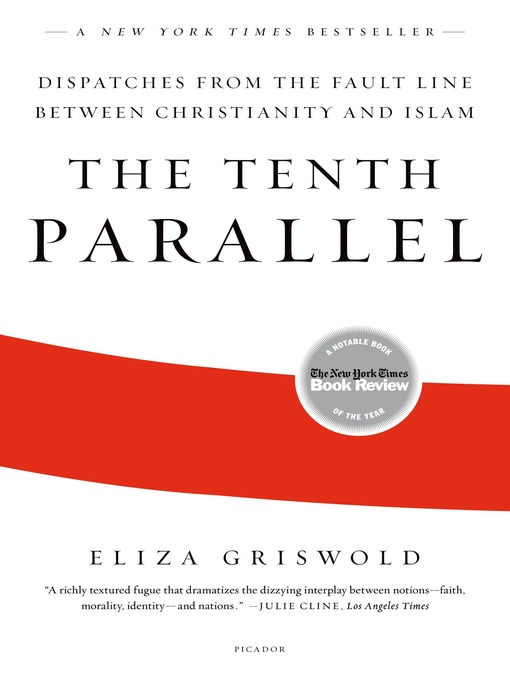
The Tenth Parallel
Dispatches from the Fault Line Between Christianity and Islam
کتاب های مرتبط
- اطلاعات
- نقد و بررسی
- دیدگاه کاربران
نقد و بررسی

Starred review from July 12, 2010
Award-winning journalist Griswold chronicles her travels along the 10th parallel, the line of latitude 700 miles north of the equator and home to many Christian-Muslim standoffs. Griswold does her best to counter the received wisdom of interfaith fighting by astutely pointing out where religion is simply used as a tactic in a nonreligious conflict over land, resources, or the like. As examples of war-rejecters, multifaith, and environmental advocates, the author introduces many organizations and individuals with hopes for peace, such as the Nigerian pastor, who, in addition to working with a Muslim imam to stop fighting between their communities, also distributes green stoves that burn less wood, thereby preventing further deforestation and possibly inter-religious fighting over land rights. The reader also meets Nigerian Christian warriors, quasi-military Filipino Catholic gangs, and Indonesian jihadis who sell herbal cures door-to-door to raise funds. Though not a scholar of Islam, Griswold has a profound grasp of the misinterpretation and manipulation of Islam. Her insight that no single, unified sharia (Islamic law) exists is a conclusion that has eluded more celebrated authors; among other perceptions, she notes that Islam was spread more by intermarriage than the sword. Always maintaining a journalist's objective view, Griswold, a published poet, nevertheless enchants the reader with her lush, flowing prose.

May 15, 2010
Stories of strife and self-identity around the beltway just north of the Equator, from Africa to Indonesia, where Christianity and Islam have shared an uneasy 1,500-year history.
Journalist and poet Griswold (Wideawake Field, 2007) traveled to Nigeria, Sudan and Somalia, on the African latitude, and Indonesia, Malaysia and the Philippines, on the Asian, to get at the root of the deep-seated conflicts between adherents of Islam and Christianity. She helpfully begins with geography, history and demographics lessons for each country, patiently explaining the Tenth Parallel's delineation in Sudan between the arid Arab north and the tribal, intermittently Christian swampy south, both vying for land, oil and water possession and manipulated by autocratic governments. Nigeria, a major petroleum producer and enormously corrupt, is fairly evenly split between Christians and Muslims, who regard each other as"objects of competition and obstacles of survival," mostly in terms of economic resources. British and American evangelicals have been building a following in Africa since the 19th century, and Griswold examines the legacy of various missionaries, many of whom still enjoy vital offshoots. In their modern manifestations, both Islam and Christianity have"reawakened" in the forms of"ecstatic experience"—Islam as fundamentalism, Christianity as evangelicalism and Pentecostalism, both casting backward for their authenticity and power, and both contentious. Though home to the world's largest Muslim population, Indonesia has a vocal Christian minority, as does its neighbor Malaysia, while the Philippines is predominately Catholic. Griswold keenly investigates how the global clash of religions especially takes its toll on women and children. She visits religious leaders on both sides and debates finer points of their arguments.
An important ongoing venture in the West's attempts to understand the conflicts of this region.
(COPYRIGHT (2010) KIRKUS REVIEWS/NIELSEN BUSINESS MEDIA, INC. ALL RIGHTS RESERVED.)

July 1, 2010
The Middle East is often viewed as the religious epicenter of the world, but journalist and poet Griswold here educates readers about another significant spiritual hot spot, taking her title from the line of latitude about 700 miles north of the equator where Christianity and Islam are burgeoning. Griswold decided to observe firsthand this "faith-based fault line" in 2003, spending several years studying and traveling across Africa and Asia to visit Nigeria, Sudan, Somalia, Indonesia, Malaysia, and the Philippines. She introduces readers to countless Christians and Muslims (e.g., pastors, missionaries, businesspeople, rectors of Islamic universities) who live, toil, and interact in this region. Though the text addresses the religious tension between two of the world's dominant theistic faiths, on a deeper level Griswold highlights the complexity and intricacy of global interactions and conflict, where worldviews and beliefs undergird the struggle for survival and natural resources: land, oil, water, jobs, etc. VERDICTThis beautifully written book will appeal to religious scholars who study pluralism, syncretism, and exclusivism. Moreover, journalists and those interested in global studies, international relations, and sociology will appreciate it as well. The "human interest" angle and Griswold's skill in storytelling cannot be gainsaid, either.—Brian Smith McCallum, Arlington Heights Memorial Lib., IL
Copyright 2010 Library Journal, LLC Used with permission.

Starred review from August 1, 2010
Griswold may be the first to explain how global warming intensifies religious conflict. For as she travels the climactically vulnerable region near 10 degrees latitude, she sees climate change exacerbating tensions dividing 700 million Muslims and 1.2 billion Christians. These tensions emerge in probing interviews with religious leadersChristian and Muslimaflame with spiritual passions now rare in the secular West. Yet Griswold also discovers how the West has helped incubate the regions interfaith hostility. It was, after all, Western colonizers whose arbitrary boundaries helped harden religious differences: in Sudan, for instance, the British established the tenth parallel as a partition between the Islamic north and the Christian south. More recently, it was the U.S.-led invasion of distant Afghanistan that triggered bloody clashes between Muslim and Christian mobs in the Middle Belt of Nigeria. And in Indonesia, Griswold listens to angry jihadists certain that the spread of fast-food restaurants signals a threatening Christian onslaught. Here and elsewhere Griswold teases out the threads of a complex fabric of religious doctrine, capitalist economics, ethnic pride, and power politics. Despite the complexities, Griswold retains her hope that authentic faith can yet transcend theological differences and foster peace. A compelling portrait of embattled human communities yearning for more-than-human succor.(Reprinted with permission of Booklist, copyright 2010, American Library Association.)

























دیدگاه کاربران